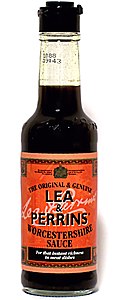This article needs additional citations for verification .(August 2010) |
 | |
| Company type | Subsidiary |
|---|---|
| Industry | Food |
| Founded | 1837 |
| Founders | John Wheeley Lea William Henry Perrins |
| Headquarters | , England |
Area served | Worldwide |
| Products | Condiments |
| Parent |
|
Lea & Perrins (L&P) is a United Kingdom-based subsidiary of Kraft Heinz, originating in Worcester, England, where it continues to operate. It is the manufacturer of Lea & Perrins Worcestershire sauce, [1] [2] a condiment first invented and sold in 1837 by chemists John Wheeley Lea and William Henry Perrins from Broad Street, Worcester.
Contents
It is currently produced in the Midland Road factory in Worcester that Lea and Perrins built. The sauce was first imported to the United States by the Duncan family of New York in 1839 and they continued to be involved for over a hundred years. [3] A subsidiary in Pittsburgh currently[ as of? ] manufactures an American version of the recipe. [4] [ failed verification ]




